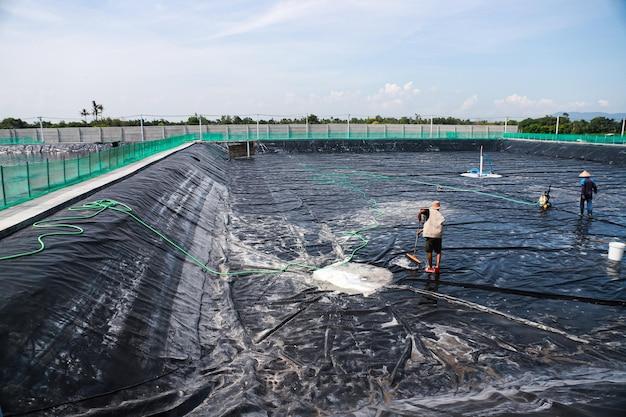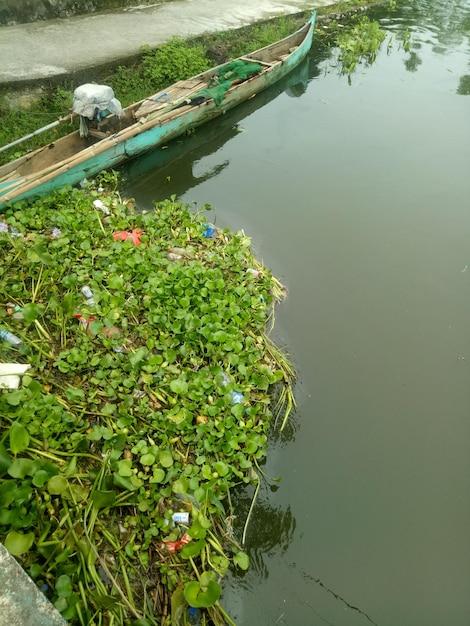Algae growth in pond liners is a common issue that many pond owners face. The greenish tint on the pond liner not only affects the overall aesthetic of the pond but also poses a threat to the health of the aquatic life within it. If you’re wondering how to tackle this problem and restore the clarity of your pond water, you’ve come to the right place. In this blog post, we will explore effective methods to remove algae from your pond liner, ensuring a clean and vibrant aquatic environment without harming the delicate balance of nature.
From natural remedies to chemical treatments, we will cover a range of options to help you find the best approach for your specific situation. Additionally, we will address common concerns such as how to clean your pond without harming frogs and which fish species can assist in keeping algae at bay. Whether you’re dealing with green pond water or simply want to prevent algae growth, this comprehensive guide will equip you with the knowledge and techniques needed to keep your pond liner in pristine condition.
So, if you’re ready to say goodbye to algae-covered pond liners and hello to a crystal-clear water feature, let’s dive in and discover the best strategies to reclaim and maintain the beauty of your pond.
How to Banish Algae from Your Pond Liner
Say Goodbye to Algae with These Easy Steps!
Algae, the unwelcome guest in your pond, can quickly turn your peaceful oasis into a slimy green mess. But fear not, intrepid pond owner! We’ve got your back with these simple and effective ways to remove algae from your pond liner.
1. Shield Your Pond from the Scorching Sun
Algae thrive under the scorching hot rays of the sun. Providing some shade to your pond can work wonders in keeping those pesky algae at bay. Consider adding floating plants like water lilies or introducing some lovely aquatic foliage. Your pond will not only look fantastic but will also provide your fish with some much-needed respite from the sun.
2. Break out the Skimmer and Brush
Grab your trusty skimmer and get to work! Skimming away any visible algae on the surface of the pond is a great way to limit its growth. Don’t forget to invest in a good pond brush as well to scrub away any algae clinging to your liner. Trust us, algae won’t stand a chance against your meticulous cleaning skills!
3. Strike a Perfect Balance with Your Pond’s Eco-System
Maintaining a harmonious eco-system is key to keeping algae in check. Balance is the name of the game here! Make sure you have the right amount of aquatic plants and fish for your pond’s size. Plants act as natural filters, absorbing excess nutrients that feed algae. Having a healthy population of fish, particularly certain breeds that love to munch on algae, can be a huge help too.
4. Keep the Pond Pumping
Your pond needs some good ol’ circulation to keep algae growth in check. A pond pump will help ensure a steady flow of water, preventing the formation of stagnant areas where algae thrive. Additionally, the gentle movement of water will discourage algae from settling on your liner. It’s like putting up a “No Algae Allowed” sign in your pond!
5. Embrace Beneficial Bacteria
No, we’re not talking about your quirky neighbor! Beneficial bacteria are nature’s secret weapon against algae. These microscopic superheroes help break down organic matter in your pond, eliminating the nutrients that algae thrive on. You can find bacteria supplements at your local pet or garden store. Trust us, your pond will thank you!
With these handy tips up your sleeve, you can bid farewell to that pesky algae and restore your pond to its former glory. Remember, a little TLC and a dash of humor can go a long way in maintaining a clean and vibrant pond. So, put on your algae-fighting cape and get to work, superhero pond owner!
Stay Pond-tastic in 2023!
FAQ: How To Remove Algae From Pond Liner
Should my pond liner be green?
No, your pond liner should not be green. A green pond liner indicates the presence of algae, which can be unsightly and harmful to the ecosystem of your pond. Fortunately, there are several methods to effectively remove algae from your pond liner.
How do you clean a pond without killing frogs?
Frogs are delightful creatures that play an important role in maintaining the balance of your pond’s ecosystem. To clean your pond without harming them, consider using natural methods such as introducing aquatic plants or using beneficial bacteria that can help control algae growth. It’s important to avoid any harmful chemicals that could harm your amphibious friends.
What fish eat algae in a pond?
Several fish species are known to have a voracious appetite for algae, helping to keep your pond clean and clear. Some of the best algae-eating fish include goldfish, koi, and grass carp. Introducing these fish into your pond can help naturally control algae growth while adding beauty and entertainment to your aquatic environment.
How do you clean algae out of a fish pond?
Cleaning algae out of a fish pond can be a daunting task. One effective method is to use a pond vacuum, which allows you to physically remove the algae from your pond’s surface and bottom. Additionally, regularly cleaning and maintaining your pond’s filtration system will help prevent the accumulation of excess nutrients that contribute to algae growth.
What is the best treatment for green pond water?
The best treatment for green pond water is to address the underlying cause of the issue, which is often an imbalance of nutrients and sunlight. Algaecides can be effective in the short term, but they do not solve the root problem and can harm beneficial organisms in your pond. Consider using natural remedies such as barley straw, which releases compounds that inhibit algae growth, or installing shading mechanisms to reduce sunlight exposure.
Should I clean algae from the pond liner?
Yes, it is important to clean algae from your pond liner to maintain its longevity and aesthetics. Algae growth on the liner can lead to discoloration and degradation over time. Regularly removing algae and cleaning the liner surface will help prevent these issues and keep your pond looking its best.
What clears pond water?
A combination of factors can help clear pond water, including proper filtration, regular maintenance, and the balance of nutrients. Ensuring your pond’s filtration system is functioning optimally will help remove excess debris and substances that contribute to cloudiness. Additionally, introducing aquatic plants and algae-eating fish can assist in keeping your pond water clear and balanced.
How do I make my pond water clear naturally?
Achieving clear pond water naturally requires a multifaceted approach. Implementing a well-designed filtration system, adding appropriate aquatic plants like water lilies and submerged oxygenators, and maintaining the appropriate balance of fish, plants, and beneficial bacteria are all important steps. Additionally, reducing the amount of direct sunlight reaching the water surface can help limit algae growth, resulting in clearer water.
What kills algae naturally?
There are several natural methods to kill algae without resorting to harmful chemicals. Implementing barley straw, which releases natural compounds as it decomposes, can help inhibit algae growth. Additionally, providing adequate aeration, introducing beneficial bacteria, and maintaining a proper balance of nutrients can all contribute to naturally controlling and reducing algae in your pond.
What is the best algae killer for ponds?
While there are a variety of products marketed as algae killers, it’s important to choose one that is safe for your pond’s ecosystem. Natural enzymes or bacteria-based treatments specifically designed to target algae can be effective alternatives to harsh chemicals. It is wise to consult with a pond professional or research thoroughly to find the best algae killer for your particular pond.
How do I keep my pond algae-free?
Maintaining an algae-free pond requires a combination of proactive measures. Regularly removing debris, limiting exposure to sunlight, introducing algae-eating fish, promoting proper water circulation, and balancing nutrient levels are all key steps to prevent algae growth. Regular monitoring and timely adjustments will help you keep algae at bay and ensure a beautiful, algae-free pond.
How do I get rid of algae in my pond liner?
To get rid of algae in your pond liner, start by physically removing any visible algae growth using a soft brush or a nylon scrub pad. Afterward, consider using a pond-safe algaecide or introducing beneficial bacteria to control and prevent further algae growth. Regular maintenance and monitoring will help ensure your pond liner remains algae-free.
How do I keep my pond liner clean?
Keeping your pond liner clean is crucial for its longevity and overall appeal. Regular maintenance, such as removing debris, checking and cleaning filters, and pruning aquatic plants, helps prevent the accumulation of nutrients that can fuel algae growth. Using a pond vacuum or a gentle pressure washer can also assist in removing stubborn dirt and algae from the liner surface.
How do I keep my pond liner from turning green?
To keep your pond liner from turning green, it’s important to establish a balanced ecosystem within your pond. This involves maintaining appropriate nutrient levels, limiting sunlight exposure by adding shading, incorporating algae-eating fish, and introducing plants that help absorb excess nutrients. Consistent monitoring and proactive measures will help prevent your pond liner from succumbing to an unwelcome green hue.
Should I clean the bottom of my pond?
Yes, it is advisable to clean the bottom of your pond periodically. Accumulated debris and organic matter can contribute to nutrient imbalances and fuel algae growth. Using a pond vacuum or a gentle water siphon, remove any sludge, leaves, or other debris that settles on the pond bottom. A clean pond bottom promotes a healthy pond ecosystem while preventing unsightly algae formations.
Remember, a clean and algae-free pond not only enhances its visual appeal but also provides a healthy habitat for the various organisms that call it home. By following these FAQs and implementing the appropriate measures, you’ll be well on your way to maintaining a vibrant and thriving pond for years to come. Happy pond cleaning!
Disclaimer: The information provided in this article is for educational and informational purposes only. Always consult with a professional pond specialist or relevant authorities for individualized advice and guidance tailored to your specific needs and circumstances.

